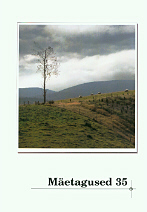Mõisakingsepa isikukogemuse lugu Rõngu kirikuraamatus ja muistendikogumikes
A Manor Cobbler’s Personal Experience Narrative in the Records of Rõngu Church and in Legend Anthologies
Author(s): Mare KaldaSubject(s): Customs / Folklore
Published by: Eesti Kirjandusmuuseum
Keywords: micro-history; legends in church logbooks; historiological narrative research; personal experience narratives; textualisation of personal experience
Summary/Abstract: Next to folklore archives and outside the oral circulation, folklore texts can also be found in quite different narrative sources. In addition to church documents and other information, the church registers of the historical parish of Rõngu from 1710-1742 include some recorded materials which could be categorised as legends and a memorate. One of the texts is a local place legend, a story how Lake Andresjärv (lit. ‘Lake of Andres’), a small inland body of water, got its name. Recorded material on the legend of Andresjärv has been analysed using the historical research method by Jürgen Beyer in his article published in 2003. Renditions of incidents associated with the Tödvens and the Tiesenhausens, once renowned families of nobility of Rannu [Randen in German] and Rõngu [Ringen in German], have been included in more recent folklore collections and the topic has been discussed in the Estonian written press in the 1920s. Furthermore, the church records of Rõngu include the tale of suffering of Torsten Grön, a Swedish manor cobbler, who lived in the late 17th century. In his youth, the man had lived and worked in Lithuania and had come upon a hidden treasure. Years later, after he had settled in Livonia, this past experience was forced upon the cobbler by haunting women who danced and tormented him in the manor hall at nights. As a result, Grön fell ill and died. Before his death he had promised a considerable donation to the local church, but his fortune was nowhere to be found. All the tales were published in 1764 in the cultural and academic journal Gelehrte Beyträge zu den Rigischen Anzeigen. The materials held in the Folklore Archives and a few legend anthologies give some idea of the fate of the tales in time and under new circumstances, which is one of the research aspects of the article. The legend of Andresjärv was published in several editions of M. J. Eisen’s book Esivanemate varandus (‘Forefathers’ Treasure’) and entered the oral lore in its printed form. The tale of the circumstances surrounding the conflict between the Tödvens and the Tiesenhausens circulated in oral lore without significant influences of a written source. Even though M. J. Eisen included the personal experience narrative of Torsten Grön in his legend anthology in 1882 (with significantly less emphasis on facts), the tale was not included in later editions. And the narrative was eventually forgotten.
Journal: Mäetagused. Hüperajakiri
- Issue Year: 2007
- Issue No: 35
- Page Range: 95-114
- Page Count: 20
- Language: Estonian

